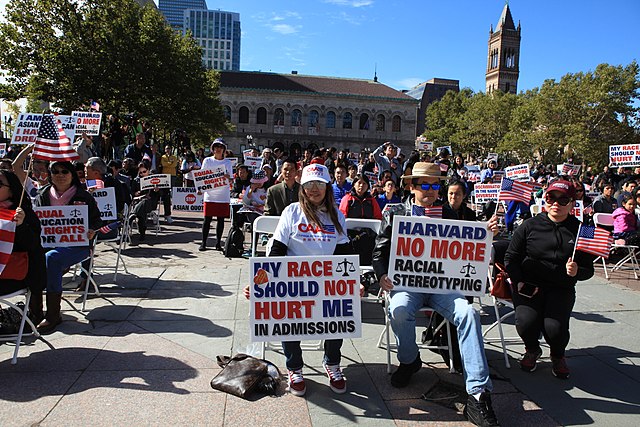On June 29, 2023, the Supreme Court ruled that Harvard and the University of North Carolina’s race-conscious admissions process was unlawful and discordant with the Equal Protection Clause. The 6-3 split decision came after Students for Fair Admissions, a conservative legal advocacy group, brought the case to the court.
The trial involved two accusations—one for each university. In both cases, plaintiffs argued that the universities’ admissions process discriminated against qualified white and Asian students in favor of less academically qualified students from underrepresented racial or ethnic groups. However, Harvard’s case added another layer; Harvard was pointedly accused of discriminating against Asian students by “using a subjective standard to gauge traits like likability, courage, and kindness,” according to the New York Times.
The universities argued that race as a factor in admissions was contextual and rare. Like many schools that use a race-conscious approach, they do so to view a student’s application holistically.
The dispute over affirmative action was originally settled in 1978. In Regents of the University of California v. Bakke, Supreme Court Justice Lewis Powell illegalized setting aside a certain number of spots for minorities. However, it was affirmed that acknowledging race, among other factors, was beneficial to facilitate a diverse, comprehensive education.
This recent ruling abrogates such a notion despite evidence that affirmative action narrows the educational opportunity gap. According to a report by the American Council for Education, the share of students of color among undergraduates increased from 30% to 45% from 1995 to 2016.
The judges who sided with the plaintiffs in the 2023 decision did so under the pretext of creating equal ground for all races. Chief Justice Roberts proclaimed, “The student must be treated based on his or her experiences as an individual — not on the basis of race.” He added that nothing prohibits the students from expressing their experiences with race in their essays.
One of the three dissenters, Justice Sonia Sotomayor, wrote that the decision is only “further entrenching racial inequality in education.” She asserts that “in a society where opportunity is dispensed along racial lines, equality cannot be attained through race blindness”.
In the 200 pages issued by the six judges in favor, Brown v. The Board of Education is understood as a lesson that, according to Chief Justice Roberts, “the time for making distinctions based on race had passed.” Justice Sotomayor, on the other hand, argues that Brown represented the need to “take affirmative, race-conscious steps to eliminate that [racial caste] system.”
The argument of the court majority is that we cannot move forward under the grasp of a phantom past. Justice Clarence Thomas’s retort to the dissenting opinion of Justice Ketanji Brown Jackson conveys this: “As she sees things, we are all inexorably trapped in a fundamentally racist society.”
The decision has raised a wave of uncertainty among the general public. A Pew Research Center poll on Asian Americans’ opinions, a group central in the discussion, revealed their ambivalence. Among those who had heard of affirmative action, 54% said it was a good thing and 27% weren’t sure. Out of all Asian respondents, 76% said race should be a factor in college admissions.
According to Robert Franek, editor-in-chief of The Princeton Review, the ruling will “result in less diverse classes.” UCLA and UC Berkeley exemplify this as they reported a significant 40% drop in their share of Black and Latino students enrolling after eliminating affirmative action in 1996. This previous fall, only 3.4% of the student body was Black.
On the other hand, Richard D. Kahlenberg, former senior fellow at The Century Foundation and author, believes class-based affirmative action is less divisive but can “achieve both diversity and social justice.”
Nevertheless, universities are finding new solutions to ensure diversity. The University of Virginia plans to target 40 high schools with little history of sending applicants. Duke University will also grant full tuition to students from certain states with a household income less than or equal to $150,000.
President and CEO of Command Education, a leading college consultant company, Christopher Rim forecasts more weight on household income and regional background during admissions. Furthermore, there will be less importance placed on ACT or SAT scores as they have been shown to reinforce race gaps. Admission officials at some selective institutes report that more importance will be placed on essays and letters of recommendation.
At ASIJ, the decision may have profound effects on the significant Asian student body looking to attend university in the United States. Whether it curbs racial discrimination or racial diversity is yet to be seen. However, seniors Yuno Inoue and Sonia Nichols shared that “it is only a disadvantage if you make it a disadvantage.” They recognize they are more privileged than others during the application process and believe there are many other ways to share their stories.

